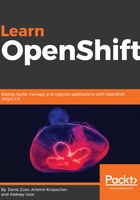
Understanding OpenShift's business value
N-tier design is a standard application design like a three-tier web app with web, application, and database tiers. This design slowly evolved into the microservice architecture. The microservice architecture influences the industry and forces many companies to embrace this new trend and make it a new standard. The microservice architecture is much cheaper, scalable, and more secure compared to the monolithic and N-tier architectures. That is why containerized applications bring you to a whole new level:

OpenShift pushes these boundaries even further, allowing both software developers and operation teams to utilize powerful microservice architecture and the simplicity of OpenShift GUI and the additional features it brings to the table. OpenShift is where you can really benefit from automation and DevOps. OpenShift has many built-in tools that allow the new microservice architecture to be backward-compatible with previous-generation software.
As we mentioned, the software development approach has also changed; initially, software developers followed a waterfall approach, polishing their apps to perfection and adding one feature after another, making sure it was bug-free. But it is neither time, nor money-efficient. That is why an agile approach came into the picture. Business owners needed shorted software development cycles. It was not perfect though, because of all the bugs and other shortcomings. The next evolutionary step was DevOps. OpenShift leverages modern DevOps processes and makes them simpler and more efficient.